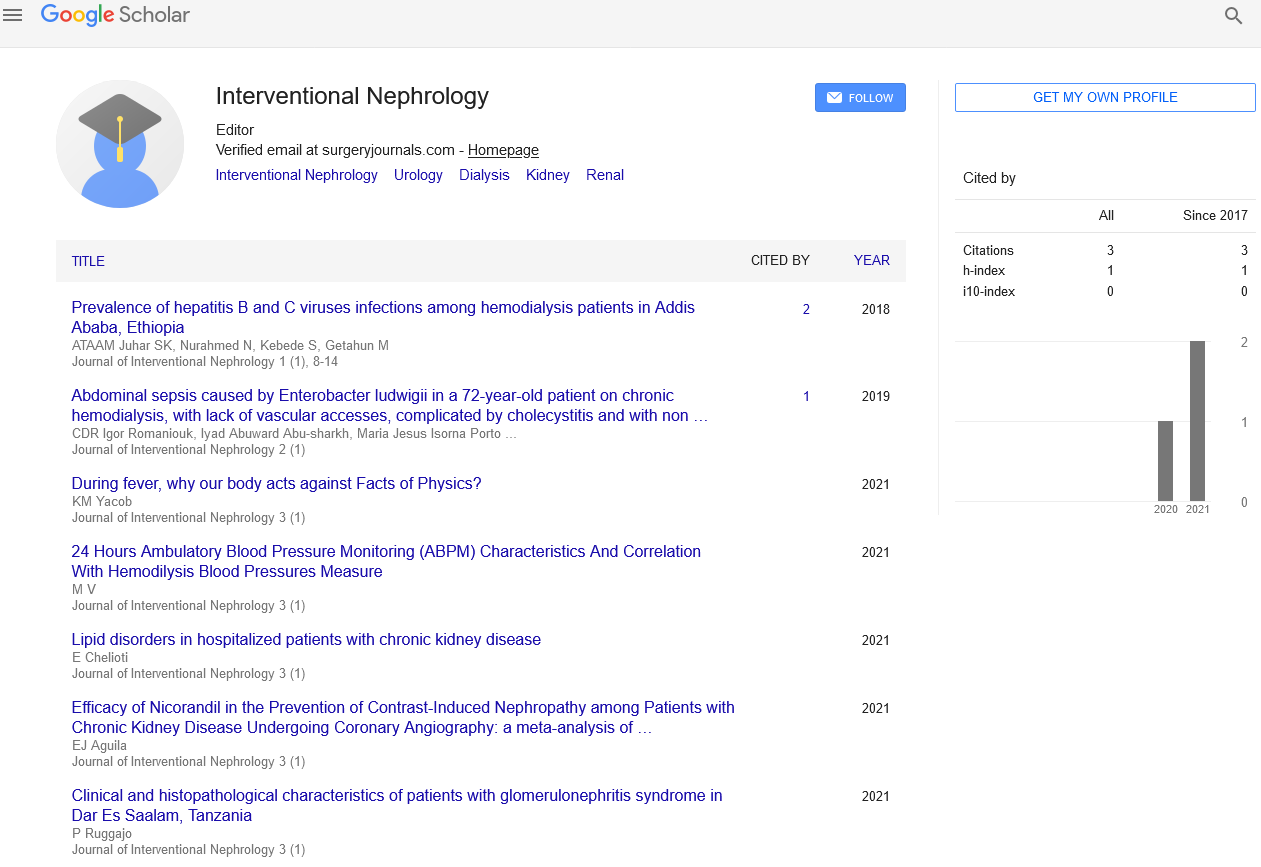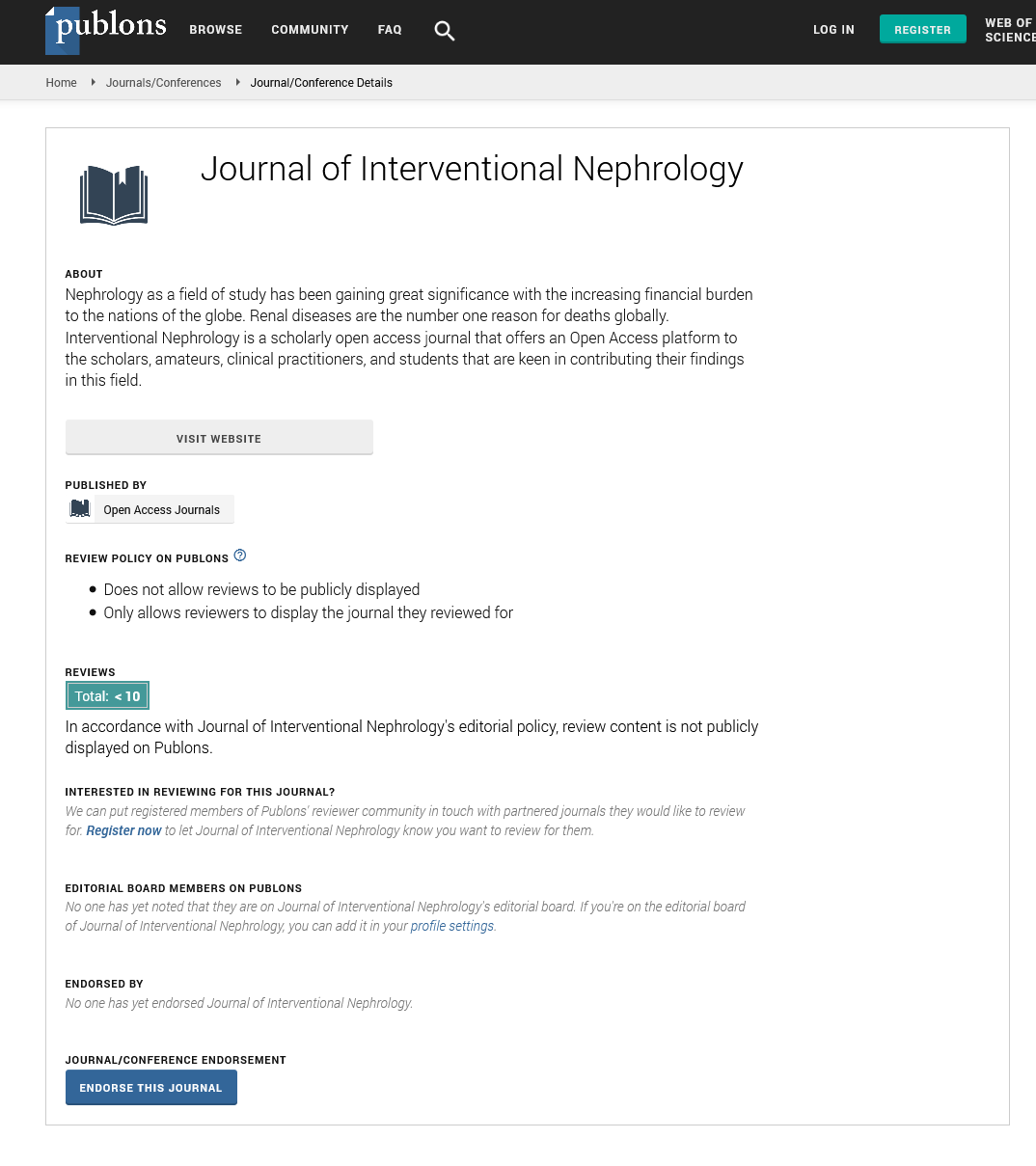Perspective - Journal of Interventional Nephrology (2024) Volume 7, Issue 2
Deciphering Renal Function Tests: A Comprehensive Guide to Evaluation, Interpretation, and Clinical Significance
- Corresponding Author:
- Vikram Saha
Department of Nephrology,
MVN University,
Italy
E-mail: vikrams44364654@edu
Received: 20-Mar-2024, Manuscript No. OAIN-24- 130173; Editor assigned: 22-Mar-2024, PreQC No. OAIN-24-130173 (PQ); Reviewed: 05-Apr-2024, QC No. OAIN-24-130173; Revised: 12-Apr-2024, Manuscript No. OAIN-24-130173 (R); Published: 22-Apr-2024, DOI: 10.47532/ oain.2024.7(2).240-241
Introduction
Renal function tests are vital diagnostic tools used to assess the health and functionality of the kidneys. In this extensive article, we delve into the intricacies of renal function tests, elucidating their purpose, methodologies, interpretation, and clinical significance in the evaluation of renal health and disease.
Understanding renal function tests
Renal function tests encompass a variety of laboratory investigations aimed at evaluating different aspects of kidney function, including Glomerular Filtration Rate (GFR), tubular function, and electrolyte balance. These tests provide valuable insights into the overall renal health and help diagnose and monitor various renal disorders.
Common renal function tests
Serum creatinine: Serum creatinine is one of the most commonly used markers of kidney function. Creatinine, a byproduct of muscle metabolism, is filtered by the kidneys and excreted in the urine. Elevated serum creatinine levels indicate impaired renal function and decreased GFR.
Blood Urea Nitrogen (BUN): Blood urea nitrogen is a measure of the amount of urea nitrogen present in the blood. Urea is produced by the liver as a byproduct of protein metabolism and is excreted by the kidneys. Elevated BUN levels may indicate impaired renal function or dehydration.
Estimated Glomerular Filtration Rate (eGFR): eGFR is a calculated value derived from serum creatinine levels, age, sex, and race. It provides an estimate of the kidney’s ability to filter waste products from the blood. A lower eGFR indicates decreased kidney function and may signify the presence of Chronic Kidney Disease (CKD).
Urinalysis: Urinalysis involves the physical, chemical, and microscopic examination of urine to assess renal and urinary tract function. It provides valuable information about urinary sediment, proteinuria, hematuria, pH, specific gravity, and the presence of glucose or ketones.
Urine electrolytes: Measurement of urine electrolytes, including sodium, potassium, and chloride, can help assess tubular function and electrolyte balance. Abnormal electrolyte levels may indicate renal tubular disorders or electrolyte imbalances.
Interpretation of renal function tests
Interpretation of renal function tests requires a comprehensive understanding of the patient’s clinical history, medications, comorbidities, and concurrent laboratory findings. Key points to consider include:
• Trend analysis of serial renal function tests
to assess disease progression or response to
treatment.
• Adjustment of test results for factors such
as age, sex, muscle mass, and hydration
status.
• Correlation of renal function tests with
imaging studies, biopsy findings, and
other diagnostic modalities to establish a
definitive diagnosis.
Description
Clinical significance and applications
Renal function tests play a crucial role in the diagnosis, monitoring, and management of various renal disorders, including:
Chronic Kidney Disease (CKD): Serial monitoring of serum creatinine and eGFR is essential for the early detection and staging of CKD, allowing for timely intervention to slow disease progression and prevent complications.
Acute Kidney Injury (AKI): Rapid changes in serum creatinine and BUN levels are indicative of acute kidney injury, necessitating prompt evaluation and management to prevent further renal damage and associated complications.
Electrolyte imbalances: Assessment of urine electrolytes helps diagnose and manage electrolyte disorders such as hyperkalemia, hyponatremia, and metabolic alkalosis, providing valuable finsfigThts finto renafl tubuflar ffunctfion.
Urinary Tract Infections (UTIs): Urinalysis aids in the diagnosis of urinary tract infections by detecting pyuria, bacteriuria, and the presence of urinary casts or crystals, guiding appropriate antimicrobial therapy.
Limitations and considerations
While renal function tests are valuable diagnostic tools, they have certain limitations and considerations:
• Creatinine-based estimates of GFR may be
less accurate in certain populations, such as
those with extremes of muscle mass, age, or
body composition.
• Interpretation of renal function tests
should consider factors that can influence
test results, including medications, diet,
hydration status, and concurrent illnesses.
Conclusion
Renal function tests are indispensable tools in the evaluation of renal health and disease, providing valuable insights into kidney function, electrolyte balance, and urinary tract integrity. Through a comprehensive understanding of the methodologies, interpretation, and clinical applications of renal function tests, healthcare providers can effectively diagnose, monitor, and manage a wide range of renal disorders, ultimately improving patient outcomes and quality of life.


